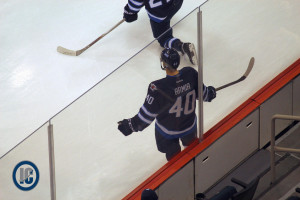
Coming to the Jets organization as one of the pieces included in the Evander Kane deal this past February, Joel (Yo-el) Armia is nothing if not controversial. The book on this Finnish forward (or at least the back cover) is that he’s loaded with skill, yet often leaves you wanting more. But let’s take a closer look.
Armia’s Strengths
At first glance, there isn’t much that Armia doesn’t offer you offensively. He has soft hands, slick dangles, a hard, accurate shot, and a quick release to boot. While he’s primarily a goal scorer, he is almost as good at setting up teammates. At 6’3, 205, he has the size and reach to get himself into dangerous areas with the puck on his stick, and he’s a good skater for a big man. I suppose you could add a little more acceleration, but in general, if you were to draw up a player, he checks almost every box in the physical skills department. When the puck is on his stick in or near the offensive zone, the opposition cringes.
Armia’s Weaknesses
The drawbacks to his game come mainly with his on-ice decision making, defensive play, and perhaps his overall “mental approach”. He sometimes tries to make plays that have low payoffs and high risks – for instance, rather than moving the puck from his own zone to an open teammate, he’ll try dangling two opponents in his own zone from a stand-still, just because he can. (Note: he actually pulled this off recently). In general, his commitment to defensive play is about what you’d expect from a young, highly skilled winger – not that great. He isn’t a liability, but he won’t be offered any time on the pk. There’s also the larger question of consistency – for a player with upper-echelon talent, why is it that he’ll be virtually unnoticeable for long stretches of time? Common explanations suggest that he “lacks intensity”, or that his work ethic is lacking. While the underlying cause of inconsistency is hard to pinpoint, it’s certainly his biggest issue. (Coach McCambridge said as much in a recent interview, which you can listen to here.)
Check out his career stats
Recent Play
While 3 goals and 7 points in 15 games don’t seem to be the makings of a dynamic offensive player, there are a few mitigating factors to consider. Firstly, most of the goals and points Armia does have were created in large part by him – for instance, the OT goal against Chicago was a nice finish on a breakaway, and the pp snipe against Lake Erie was a rocket of a wrist shot from the slot. He’s also delivering primary assists on plays he himself created, like the 2-on-1 last game where he carried the puck in and fed J.C Lipon for a tap-in. Further, when you consider that the Moose are currently the lowest scoring team in the AHL with just 26 goals (most teams have around 40, and the Toronto Marlies lead with 74!), there aren’t many secondary assists padding the stat sheets for the Moose.
Having watched Armia play a lot this season, I can tell you that this season’s stats don’t tell the full story. Armia has been creating lots of chances – both for himself, and his teammates – and he’d probably have quite a few more points if he was surrounded with a bit more talent to finish more plays off. Outside of the goaltenders, almost every player on the Moose struggled in the first 6 games of the season, Armia included. (The team went 0-4-1-1, and were outscored 18-to-7). But since then, he has been one of their best players game-in and game-out, and has shown a surprising level of consistency. (Again, Coach McCambridge noted this in the interview linked to above). He is usually among the top-3 Moose players in the 9 games I’ve watched, and I’ve even been pleasantly surprised on a few occasions by his battle and physicality.
Future with the Organization
The call-up comes at a sensible time for both player and team – Armia’s play has earned him a shot, and the Jets – who had just 12 forwards due to the demotion of Nic Petan – probably want to take a look to figure out if he fits long-term. This may be a watershed moment for Armia: at 22 years of age, and on the last year of his Entry-Level Contract, not only will he need a new contract next season, but he’ll also be waiver-eligible. Assuming the Jets do re-sign him, he’d need to pass through waivers if he’s not able to stick with the Jets, meaning any other team could claim him. Furthermore, while it seems like he’s still quite young, most of the 1st round picks from the 2011 Entry Draft have already established themselves as NHL players. At some point, even the most optimistic GM’s will start writing off former high draft picks with unfulfilled promise, and typically that begins to happen in one’s mid-20’s. (While playing styles differ, former 1st rounders like Colton Gillies, Rob Schremp, and Ryan O’Marra all got their last shot around age 24).
Final Thoughts
It will be very interesting to watch Armia in his Jets debut – though when that may come is still up in the air. Ideally he’ll get a chance to play with at least one other creative offensive player – Burmistrov or Ehlers – in order to complement his own skill and creativity. That said, putting all three together may be unlikely, as that might present too much uncertainty / puck mismanagement for Paul Maurice’s liking. Regardless of how Armia fares in his debut, bear in mind that he has only played 1 NHL game to date, so it’s unfair to expect a seamless transition to hockey’s highest level of play.




